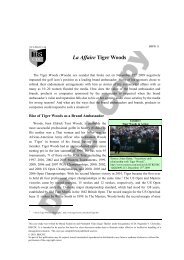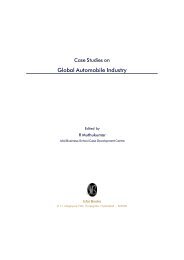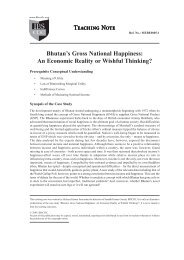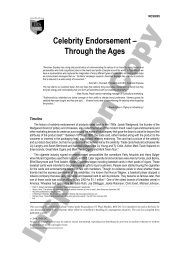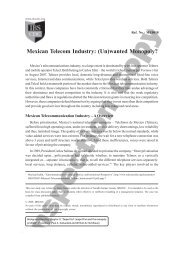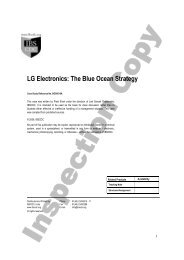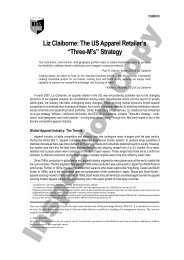List of Case Studies on Strategy - Case Catalogue IV
List of Case Studies on Strategy - Case Catalogue IV
List of Case Studies on Strategy - Case Catalogue IV
You also want an ePaper? Increase the reach of your titles
YUMPU automatically turns print PDFs into web optimized ePapers that Google loves.
8<br />
Restructuring estructuring T TTurnaround<br />
T urnaround Strategies<br />
Strategies<br />
• To discuss the technological changes that<br />
happened in the UK broadcast industry.<br />
Industry Broadcasting Industry<br />
Reference No. RTS0168B<br />
Year <str<strong>on</strong>g>of</str<strong>on</strong>g> Pub. 2007<br />
Teaching Note Available<br />
Struc.Assig. Available<br />
Keywords<br />
BBC; Royal charter; Technology; CNN;<br />
Restructuring / Turnaround Strategies <str<strong>on</strong>g>Case</str<strong>on</strong>g><br />
Study; CableTV; Licence fee<br />
Delta Air Lines: Flying out <str<strong>on</strong>g>of</str<strong>on</strong>g><br />
Bankruptcy?<br />
Delta Air Lines Inc., <strong>on</strong>e <str<strong>on</strong>g>of</str<strong>on</strong>g> the leading<br />
carriers in the US, filed for Chapter 11<br />
bankruptcy protecti<strong>on</strong> <strong>on</strong> September 14th<br />
2005. Delta’s bankruptcy was ascribed to a<br />
variety <str<strong>on</strong>g>of</str<strong>on</strong>g> factors ranging from September<br />
11th 2001 terrorist attack <strong>on</strong> the US to<br />
soaring fuel prices. Delta, which had<br />
survived an initial takeover bid by US<br />
Airways earlier in November 2006, was<br />
optimistic about its future as an independent<br />
airline. On January 31st 2007, US Airways<br />
withdrew its subsequent $10.2 billi<strong>on</strong> bid<br />
to take over Delta Airlines, after it failed<br />
to c<strong>on</strong>vince Delta’s creditors. US Airways’<br />
<str<strong>on</strong>g>of</str<strong>on</strong>g>fer for Delta had been viewed by analysts<br />
as a deal that would set the t<strong>on</strong>e for airline<br />
industry c<strong>on</strong>solidati<strong>on</strong> in the US. What are<br />
the implicati<strong>on</strong>s <str<strong>on</strong>g>of</str<strong>on</strong>g> Delta’s bankruptcy <strong>on</strong><br />
the US airline industry? What does the<br />
future hold for Delta Airlines? Will the<br />
restructuring efforts <str<strong>on</strong>g>of</str<strong>on</strong>g> Delta be successful?<br />
Will Delta emerge out <str<strong>on</strong>g>of</str<strong>on</strong>g> bankruptcy and<br />
retain its independence?<br />
Pedagogical Objectives<br />
• To understand the c<strong>on</strong>tributi<strong>on</strong> <str<strong>on</strong>g>of</str<strong>on</strong>g> US<br />
airline industry to the overall ec<strong>on</strong>omic<br />
performance <str<strong>on</strong>g>of</str<strong>on</strong>g> the country<br />
• To provide an overview <str<strong>on</strong>g>of</str<strong>on</strong>g> the US airline<br />
industry and the competitive scenario<br />
• To discuss about various factors that<br />
c<strong>on</strong>tributed to Delta Airlines’ bankruptcy<br />
• To discuss how Delta is trying to emerge<br />
out <str<strong>on</strong>g>of</str<strong>on</strong>g> bankruptcy and it’s restructuring<br />
plans<br />
• To analyse the scope and limitati<strong>on</strong>s <str<strong>on</strong>g>of</str<strong>on</strong>g><br />
c<strong>on</strong>solidati<strong>on</strong> in the US airline industry.<br />
Industry Airline Industry<br />
Reference No. RTS0167B<br />
Year <str<strong>on</strong>g>of</str<strong>on</strong>g> Pub. 2007<br />
Teaching Note Available<br />
Struc.Assig. Available<br />
Keywords<br />
Delta Air Lines; Airline Industry; Legacy<br />
Carriers; Network Carriers; Bankruptcy;<br />
Turnaround Strategies; Chapter 11;<br />
Operating Cost; CASM; Deregulati<strong>on</strong>;<br />
www.ibscdc.org<br />
Business Model; US Airways; Restructuring<br />
/ Turnaround Strategies <str<strong>on</strong>g>Case</str<strong>on</strong>g> Study; Gerald<br />
Grinstein; LCCs<br />
Boeing: Back <strong>on</strong> the Track?<br />
The year 2006 had been a record-breaking<br />
year for Boeing Company which was also<br />
a year to remember as this accomplishment<br />
came after several setbacks since 2003<br />
which resulted in Boeing losing its leadership<br />
to Airbus. The company received a record<br />
number <str<strong>on</strong>g>of</str<strong>on</strong>g> airplane orders, which surpassed<br />
that <str<strong>on</strong>g>of</str<strong>on</strong>g> its rival – Airbus. Industry observers<br />
felt that several factors led to Boeing’s<br />
success. One <str<strong>on</strong>g>of</str<strong>on</strong>g> the reas<strong>on</strong>s cited was the<br />
management strife and other problems at<br />
Airbus. Other reas<strong>on</strong>s that c<strong>on</strong>tributed to<br />
Boeing’s increase in orders included<br />
Boeing’s product strategy and increasing<br />
fuel prices which made Boeing’s fuelefficient<br />
airplanes desirable. With a<br />
triumphant 2006, it remains to be seen if<br />
Boeing would regain its lost leadership and<br />
sustain the same.<br />
Pedagogical Objectives<br />
• The case deals with the growth strategies<br />
<str<strong>on</strong>g>of</str<strong>on</strong>g> Boeing company<br />
• The case analyses the challenges and<br />
problems encountered by Boeing<br />
• The case examines the competitive<br />
stand-<str<strong>on</strong>g>of</str<strong>on</strong>g>f between Boeing and Airbus<br />
• The case analyses the different<br />
restructuring strategies <str<strong>on</strong>g>of</str<strong>on</strong>g> Boeing to<br />
combat its challenges<br />
• The case deals with the product strategy<br />
<str<strong>on</strong>g>of</str<strong>on</strong>g> Boeing<br />
• It analyses the various factors behind<br />
Boeing’s success<br />
• It analyses whether the events <str<strong>on</strong>g>of</str<strong>on</strong>g> the<br />
year 2006 would help Boeing lead the<br />
market.<br />
Industry Aircraft Manufacturing<br />
Reference No. RTS0166B<br />
Year <str<strong>on</strong>g>of</str<strong>on</strong>g> Pub. 2007<br />
Teaching Note Available<br />
Struc.Assig. Available<br />
Keywords<br />
Boeing;Airbus; Dreamliner; B-787;<br />
Commercial Aircraft; Miltray Aircraft;<br />
Restructuring / Turnaround Strategies <str<strong>on</strong>g>Case</str<strong>on</strong>g><br />
Study; US Air Force; McD<strong>on</strong>nell Douglas;<br />
Defense; Lockheed Martin; Pentag<strong>on</strong>;<br />
Plastic Composites; Air Freight; Tankers;<br />
FAA<br />
Wal-Mart in Japan: Survival and<br />
Future <str<strong>on</strong>g>of</str<strong>on</strong>g> its Japanese Business<br />
Localisati<strong>on</strong> is the buzz word for a<br />
successful global business. Japan’s retail<br />
market, the sec<strong>on</strong>d largest in the world,<br />
accounts for ¥130 trilli<strong>on</strong>. It is<br />
characterised by a unique c<strong>on</strong>sumer<br />
behaviour, distributi<strong>on</strong> system and increased<br />
retailer density. These challenges hamper<br />
the success <str<strong>on</strong>g>of</str<strong>on</strong>g> global retailers who tried to<br />
transplant the business model from their<br />
parent country into the Japanese market.<br />
Analysts attribute that lack <str<strong>on</strong>g>of</str<strong>on</strong>g> localisati<strong>on</strong><br />
and adopti<strong>on</strong> <str<strong>on</strong>g>of</str<strong>on</strong>g> the ‘cookie-cutter’<br />
approach in foreign markets as the main<br />
reas<strong>on</strong> for their failure. Wal-Mart, the<br />
world’s largest retailer has been daunted by<br />
the five c<strong>on</strong>secutive years <str<strong>on</strong>g>of</str<strong>on</strong>g> losses since<br />
its entry into Japan in 2002.It entered<br />
Japan by acquiring Seiyu, a struggling<br />
Japanese retail chain. Despite<br />
implementing many strategies, Wal-Mart<br />
was not able to successfully execute its US<br />
model in Japan. By mid-2007, Wal-Mart<br />
had invested $1 billi<strong>on</strong> in Japan and had<br />
made Seiyu its wholly owned subsidiary, by<br />
acquiring a 53% stake. The year 2007 was<br />
relatively better. The net loss for the first<br />
quarter <str<strong>on</strong>g>of</str<strong>on</strong>g> 2007 had declined to ¥4.4 billi<strong>on</strong><br />
compared to the net loss <str<strong>on</strong>g>of</str<strong>on</strong>g> ¥52.8 billi<strong>on</strong><br />
in the first quarter <str<strong>on</strong>g>of</str<strong>on</strong>g> the previous year. In<br />
spite <str<strong>on</strong>g>of</str<strong>on</strong>g> this positive trend, analysts suggest<br />
that Wal-Mart should sell Seiyu and give<br />
up its Japanese operati<strong>on</strong>s. Wal-Mart<br />
however is committed to Japan.<br />
Pedagogical Objectives<br />
• To analyse the retail industry scenario<br />
in Japan<br />
• To analyse Wal-Mart’s successful US<br />
retail model<br />
• To compare and c<strong>on</strong>trast the retail<br />
market characteristics in developed<br />
ec<strong>on</strong>omies, viz. Japan and the US<br />
• To analyse the strategies to be adopted<br />
by Wal-Mart for survival and growth in<br />
Japan.<br />
Industry Retailing<br />
Reference No. RTS0165C<br />
Year <str<strong>on</strong>g>of</str<strong>on</strong>g> Pub. 2007<br />
Teaching Note Available<br />
Struc.Assig. Available<br />
Keywords<br />
Wal-Mart; Japan; Retail; Retail Market<br />
Scenario in Japan; Keiretsu; Seiyu;<br />
C<strong>on</strong>sumer Behaviour; Restructuring /<br />
Turnaround Strategies <str<strong>on</strong>g>Case</str<strong>on</strong>g> Study; Japanese<br />
Distributi<strong>on</strong> System; Developed Ec<strong>on</strong>omy;<br />
Business Envir<strong>on</strong>ment; Survival Strategies;<br />
Localisati<strong>on</strong> Strategies; Revenue Models;<br />
<strong>Strategy</strong>; Ec<strong>on</strong>omics<br />
Heineken's Amstel Light Struggles<br />
to Recoup its No. 1 Positi<strong>on</strong> in the<br />
US: Would its <strong>Strategy</strong> Work?<br />
In the 1980s, with the increasing<br />
c<strong>on</strong>sumpti<strong>on</strong> <str<strong>on</strong>g>of</str<strong>on</strong>g> light beer in the US<br />
alcoholic beverage market, Heineken N.V.,



